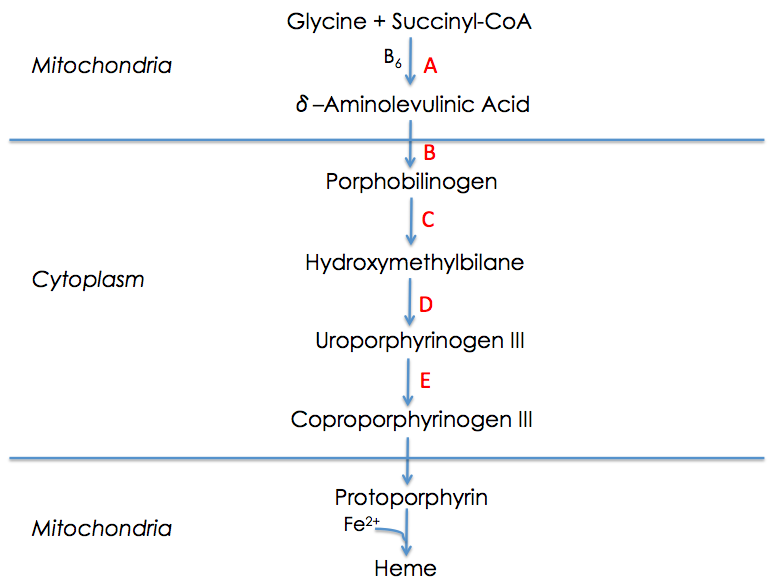WBR0347
| Author | [[PageAuthor::Rim Halaby, M.D. [1]]] |
|---|---|
| Exam Type | ExamType::USMLE Step 1 |
| Main Category | MainCategory::Pathophysiology |
| Sub Category | SubCategory::Hematology |
| Prompt | [[Prompt::A 25 year old male patient, previously healthy, presents to the physician's office complaining of blistering vesicles over different parts of his body. He reports that he has had previous episodes in the past, all of which occur following exposure to sunlight. The patient then adds that he also notices that his urine has a reddish brown discoloration under natural light. Based on the simplified diagram of heme synthesis shown below, which enzyme is most likely deficient in this patient? |
| Answer A | AnswerA::A |
| Answer A Explanation | AnswerAExp::"A" corresponds to ALA synthase, deficient in B6 deficiency. |
| Answer B | AnswerB::B |
| Answer B Explanation | AnswerBExp::"B" corresponds to ALA dehydratase, deficient in lead toxicity. |
| Answer C | AnswerC::C |
| Answer C Explanation | AnswerCExp::"C" corresponds to porphobilinogen deaminase, deficient in acute intermittent porphyria. |
| Answer D | AnswerD::D |
| Answer D Explanation | AnswerDExp::"D" corresponds to uroporphyrinogen III synthase, which is not clinically relevant. |
| Answer E | AnswerE::E |
| Answer E Explanation | AnswerEExp::"E" corresponds to uroporphyrinogen decarboxylase, deficient in porphyria cutanea tarda (PCT). |
| Right Answer | RightAnswer::E |
| Explanation | [[Explanation::The patient is presenting with porphyria cutanea tarda (PCT). Porphyria cutanea tarda is characterized by the deficiency of the enzyme uroporphyrinogen decarboxylase. In PCT, patients typically have acute skin eruptions of blistering vesicles that occupy different parts of the patient's body. These vesicles appear in sun-exposed areas and are exacerbated by sunlight and typically arise a few days after exposure to sun. Due to increased levels of uroporphyrinogen in the urine, the color of the urine becomes reddish brown under natural light and pinkish under Wood's lamp. PCT may be familial or sporadic. Sun avoidance, and reduction of iron stores (phlebotomy and chelation) are important in the management of the patient.
Educational Objective: Porphyria cutanea tarda is characterized by a deficiency of uroporphyrinogen decarboxylase. Reference:
Munoz-Santos C, Guilabert A, Monero N, et al. Familial and sporadic porphyria cutanea tarda: clinical and biochemical features and risk factors in 152 patients. Medicine (Baltimore). 2010;89(2):69-74. |
| Approved | Approved::No |
| Keyword | WBRKeyword::porphyria, WBRKeyword::cutanea, WBRKeyword::tarda, WBRKeyword::PCT, WBRKeyword::photosensitivity, WBRKeyword::urine, WBRKeyword::pink, WBRKeyword::pinkish, WBRKeyword::red, WBRKeyword::reddish, WBRKeyword::brown, WBRKeyword::brownish, WBRKeyword::color, WBRKeyword::discoloration, WBRKeyword::uroporphyrinogen, WBRKeyword::decarboxylase, WBRKeyword::blister, WBRKeyword::vesicle, WBRKeyword::blisters, WBRKeyword::vesicles, WBRKeyword::heme, WBRKeyword::pathway, WBRKeyword::Wood, WBRKeyword::Wood's, WBRKeyword::lamp, WBRKeyword::ultraviolet |
| Linked Question | Linked:: |
| Order in Linked Questions | LinkedOrder:: |
